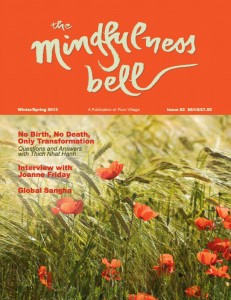
An Interview with Joanne Friday
Joanne Friday is a Dharma Teacher in the Order of Interbeing. In 2003, she received authority to teach from Thich Nhat Hanh, her teacher for twenty years.
Joanne leads meditation retreats for Sanghas and groups throughout the Northeastern U.S. She lives in Rhode Island, where she is the guiding teacher for the six Sanghas that comprise the Rhode Island Community of Mindfulness. She is also an Associate Chaplain at the University of Rhode Island. Joanne was interviewed by Natascha Bruckner on October 11, 2012.
Mindfulness Bell: Today, October 11, is Thay’s Continuation Day. How do you see his continuation in yourself?
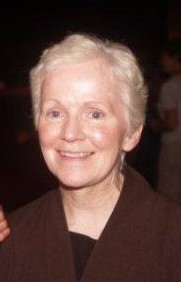 Joanne Friday: My ordination as a Dharma Teacher was a clear example of how I see transmission and continuation. I had no thoughts of ever being a Dharma Teacher; it never had entered my mind. One day I received a letter from Plum Village inviting me to receive Lamp Transmission. After opening the letter, I went through feeling completely unworthy, and I thought, “Oh, they’ve made a mistake—my name was switched with some other person.” I really was stunned. After two minutes or so, it was as if I was struck by a bolt of lightning and I thought, “This has nothing to do with you.”
Joanne Friday: My ordination as a Dharma Teacher was a clear example of how I see transmission and continuation. I had no thoughts of ever being a Dharma Teacher; it never had entered my mind. One day I received a letter from Plum Village inviting me to receive Lamp Transmission. After opening the letter, I went through feeling completely unworthy, and I thought, “Oh, they’ve made a mistake—my name was switched with some other person.” I really was stunned. After two minutes or so, it was as if I was struck by a bolt of lightning and I thought, “This has nothing to do with you.”
Since my first encounter with Thay, I have felt him to be very alive in every cell of my body. And the transmissions from my parents, from everybody who’s ever loved me, everybody who’s ever cared for me, all of them are alive in every cell in my body. So to say that is not good enough is an insult to all of them. This was not about my little egocentric self; it had nothing to do with me.
To prepare for the ceremony, my normal habit energy would have been to try to come up with the perfect Dharma talk, and have everybody think I knew everything about the Dharma. Instead, I could not even think about it and I had not one ounce of anxiety in those three months before the Lamp Transmission. At that time, as part of the ceremony, each new Dharma teacher gave a short talk after their ordination. Walking to take my seat, I still had no idea what I would talk about, and yet I felt nothing but pure joy, and I thought, “I wonder what I’m going to say.” So I told them the story I am telling you.
I said, “Thay gives a beautiful teaching on no-birth, no-death, using a sheet of paper. I received another deep teaching on non-self from a sheet of paper. I got this letter asking me to be here and this was my experience—I realized it is all about my non-self elements; it has nothing to do with me. It’s been so much fun; it feels so free.
This is really amazing. I have almost no self-confidence, but I have total confidence in my non-self elements; clearly I do because I haven’t been the least bit anxious, and so I think I am experiencing non-self confidence.” And Thay was laughing and everyone was laughing.
And that has been the truth ever since. If I get invited to share the Dharma, I do my best to stay out of it. My goal in sharing the Dharma is to transmit what was transmitted to me and leave my little self out of it. And I don’t get tired. If my ego starts getting involved, I get tired, and so it is a good indicator that I need to go do some walking meditation and get out of the way.
MB: I went to your Day of Mindfulness in Portola Valley, California. I remember that you talked about your own life and challenges you’ve had. You are transmitting what you’ve learned and you’re getting out of your own way, and yet you are talking about your own life. I’m wondering about the balance between those two.
JF: I don’t think any of us experience things that are unique to us. When we experience suffering, the story line may be different for each of us, but suffering is suffering and that is universal. I think that’s where we can really understand interbeing. I share my own experience because the Buddha said to trust your wisdom, trust your experience. When I speak from my own experience, I can speak with conviction, because it’s true for me. Hopefully it will be something that others can put to use, too. My interest in Buddhism is how we apply the practices that the Buddha gave us to the suffering we encounter in our daily life, to transform it and become free.
Gentle Diligence
MB: Would you be willing to give an example from your own life of how you have used the practice to get free?
JF: Probably the most profound example was getting a diagnosis of cancer. My mother was dying at the time and she had been in the hospital. I had just signed her over into hospice care, and I went downstairs to the waiting room and got a call saying I had cancer. I remember feeling as if ice water were running over my body. Real fear. But within a minute, I breathed, I sent metta to myself, and then the question came to my mind: “Are you sure?”
As soon as I asked the question, I felt peace, because I realized, “I have no idea. It could be almost nothing; it could be death. I don’t know.” So for me to get all wound up about it would really not make sense. I realized, “I need to find out, and that’s it. And right now, I need to be present for my mother in the hospital.”
The first thing was breathing. The breath was right there as the default position. The second was metta. I have practiced metta for twenty years, so it was right there. And then to ask, “Are you sure?” That takes me right to nonattachment to view and “don’t know mind.” And in “don’t know mind,” there’s every possibility. It’s such a wonderful place.
And then I thought, “Wow, I’ve been practicing the Five Remembrances* for years.” I have been aware of impermanence, but never as aware as when I got that phone call. The next thing that came to mind was: “If you have limited minutes to be on the planet”—later I thought it was really comical to think in terms of “if ” —“how many of them do you want to spend in fear and speculation?” And the answer was, “Zero.”
So that, to me, is a clear and concise example of how the practice can be applied in daily life. And the most beautiful thing to me was, going through a year of cancer treatment, I probably didn’t spend more than maybe a half an hour in the entire year in fear and speculation. I told my husband, “You know, the real tragedy wouldn’t be to die of cancer; to me, the real tragedy would be to have wasted this time.” To not have enjoyed the time I did have.
That was reinforced after the first chemotherapy infusion I had. I was treated in New York City, and as we walked out of the hospital, a bus came around the corner cutting in too close, and my husband pulled my arm and yanked me back from it. He said, “Be careful, they’re driving like crazy people.” He looked at me, I looked at him, and we just cracked up.
I said, “Wouldn’t that be ironic, here we are, we’re convinced I’m going to drop dead of cancer, and instead we get hit by a cross-town bus.” [Laughs.] It was such a beautiful teaching, because we have no clue when the time will come or how it’s going to happen. Becoming more comfortable with impermanence is such a relief. It really frees us up to enjoy life.
MB: That is an incredible example. Thank you. You used all these potent tools one after the other in a very short period of time.
JF: It’s just following directions. Thay offers the practice in a very gentle way, instructing us to be gentle with ourselves, to not do violence to ourselves. At that point I had been practicing for about seventeen years, and I felt like I had a very laid-back practice. I felt like I was probably not strengthening my mind as much as I could, my practice was not as rigorous as other practices, and I was not sure if it was as solid as it needed to be. But clearly the benefits of gentle diligence over time were there because there had been absolute transformation at the base.
I can usually only see progress in my practice by noticing that I am responding very differently to a situation than I would have reacted ten years earlier. In this instance, I would have been completely tied up in knots; I would have been a nervous wreck. I would have been trying to figure out what was going to happen and completely caught in fear and speculation. I know that my mind had been trained in that way.
But the training in gentle diligence, paying attention in everyday life, and taking good care of strong emotions when they come up really paid off. When attachment to views arose, it was such a gift to be able to look clearly, to not get caught in the surface of things. And to just do that over and over and over and over and over and over. If we practice like that, when the going gets tough, the practice is there for us.
MB: That’s a beautiful example of how we can train our minds without effort, without stress.
JF: We don’t have to create a war with ourselves. There doesn’t have to be any judgment, criticism, any of that. It’s just to notice, and to do the practice, then to notice. To strengthen our mindfulness and concentration.
Healing the Inner Child
MB: In the book Reconciliation: Healing the Inner Child, you tell a wonderful story of transforming your anger to compassion by connecting with your inner three-year-old. Do you connect with your inner child on a regular basis? What have you found helpful in keeping her nourished and happy?
JF: When I went to my first retreat, I signed up for a consultation with Thay Phap An [a senior Plum Village monk, now Director of the European Institute of Applied Buddhism in Germany]. I was brain-injured from a car accident and I was in a state of real confusion. I wanted to talk about a woman who had been very angry with me, so I said, “There’s this woman, she’s a really angry person.” And he said, “That’s not correct.” He said that whenever we assign a label to anyone or anything, it’s incorrect, because everything is impermanent. So we’re assigning a permanent status to something that is inherently impermanent. That has been a wonderful teaching; I use it all the time.
And then he went on to teach me about healing the past in the present moment and doing Beginning Anew with myself. It was such a training in the ability not to hold on to resentment and anger. And to look at myself and ask, “What is this person bringing up in me?”
I’ve been doing the practice of healing the inner child ever since. There’s hardly been a day that I haven’t used it, in one way or another. When I’m experiencing a strong emotion, I simply notice and embrace that feeling, breathe with it, and hold it. For me, just being with that feeling will usually bring a memory back of another time and place. It might have been last week or it might have been when I was three.
It inevitably takes me to times and places when I needed love and compassion and I didn’t get it. So my job is to provide that for myself. I can show that child a lot of love and compassion. My main goal in the practice is to bring the child into the present moment, to let her know the good news that she is no longer three. We’re adults now, and if people are yelling, we can leave. We don’t have to be there.
Many people do not access memories from the past when they embrace difficult emotions. If that is the case, you can breathe and send metta to yourself in the present because that child is still alive inside of you. A lot of healing can happen by doing this practice—accepting what is in the present moment and accepting ourselves unconditionally.
MB: How is your inner child today?
JF: I think that she is doing better and better, every day in every way. [Laughs.] I find there are fewer times that I need to spend a lot of time with her. Mostly now it’s a recognition, like Thay says about his anger: “Hello anger, my little friend, you’re back again.”
About fifteen years ago, my husband Richard and I were at a retreat and we were practicing noble silence. He gave me a note that said, “I called home, and so-and-so left a message. She wanted to borrow this thing of yours, so I called her back and said sure.” I was over-the-top enraged. And I was surprised at how angry I was, because I thought, “If I had retrieved the phone call, I would have called her back and said sure.” So I knew there was more to this than was meeting my eye.
Luckily we were in noble silence, so I couldn’t say a word. I sat myself down, did my breathing, did my metta for myself, and then I invited that feeling up and what I found was [a feeling of] not being considered. When I invited the rage up in me, I was transported back to being eleven years old. At that time, I had a surrogate father. This guy who lived upstairs fell in love with me when I was a month old, and he was a blessing in my life. He showed me unconditional love and was prominent in my life until I was eleven, when he died of a heart attack.
Sitting on my cushion, when I got in touch with the rage, I was transported right back to the conversation when my parents told me he had died. They said he had the heart attack two days before, but they didn’t want to tell me because they didn’t want me to see him with tubes in his body; they thought that would be too upsetting for an eleven-year-old. And now he was dead. I realized that I had completely buried that memory. If you had asked me a week before, I would have had no recollection of that conversation ever happening. As I was sitting, I realized that to be told someone is dead when you are eleven—there’s nothing you can do about that. So I surmise that I was enraged because they had made a decision concerning the most important thing in my life and nobody asked me.
When I went back to revisit the conversation as an adult, I could give that eleven-year-old all the understanding and love and compassion that she needed, that she didn’t get at that time. I could validate her rage at not being considered. And I could see my parents as only trying to be good parents. It was all with the best of intentions that they created the situation. To see it all with no criticism, no blame for any of us, just understanding and compassion.
Thay says mindfulness leads to concentration, concentration to insight, insight to understanding, understanding to compassion. That’s how it works. I find that to be true every time. When I get to that place of understanding, there’s nothing but compassion. I wind up feeling compassion for myself, feeling compassion for my parents, and feeling compassion for my husband, because I look at him and think, poor guy, there he is trying to do something wonderful and here sits his wife, who is enraged. He knows nothing about this baggage I’m carrying.
MB: That story took place in the context of a retreat, where you were in noble silence and you were able to go deeply and work through these things internally. I’m curious how you would advise people who are in the midst of a busy life, when a trigger like this comes up, but it’s not in the context of a retreat.
JF: Most of the retreats I offer are in silence because of my experiences of this kind of healing. To be able to practice in silence helps me develop my mindfulness and concentration. And it helps me to hard-wire in the practice, so that when I am in the rest of my life, where there is not noble silence and most people aren’t practicing at all, that gentle diligence kicks in; it becomes a default. I can recognize that I have been overreacting to not being considered for over forty years. The blessing is that I don’t have to be controlled by it. I don’t have to react blindly out of ignorance to what I’m carrying around.
Once I know that there’s a block of suffering in me that can be watered and brought to the surface, I can recognize it for what it is and I don’t have to react to it. If I’m in my daily life and somebody does or says something that’s hurtful, I make a note of it. I’ll try to say, “For future reference, the next sit I do, I need to spend some time with that.” I just make an appointment with myself to take good care of that.
The more that I do it, it doesn’t take long at all. It’s not like I have to sit for three hours and work with it. It’s a very quick recognition now, for the most part, and I can go do walking meditation. If I can do a ten- or fifteen-minute walk, I can calm myself, get the mud to settle out of the water, then I know what to do and what not to do.
Making Good Use of Suffering
MB: What experiences in your own life have been most valuable in serving you as a Dharma teacher?
JF: I would say suffering. There’s nothing quite like it to help us to wake up. Thay says that he wouldn’t want a nirvana without suffering, and I can see why. The brain injury from a car accident is what brought me to the path, so suffering got me here. I look back at any suffering I’ve had in my life and ask: “What did it have to teach me? Did I benefit? Did I make good use of it?” If I didn’t make good use of the suffering, then it’s a waste of time.
MB: In Reconciliation, you write that you “discovered that mindful speech isn’t just choosing the right words to say—it’s transforming the ill will in my heart.” What guidance would you give to someone who wants to transform the ill will in his or her heart?
JF: One of the things I’ve been practicing with a lot is looking at stories that I’ve been told about myself or that I make up about myself and others. And getting caught in the surface of those stories and believing them. When someone does or says something hurtful, Thay invites us to look deeply, to not get caught in the surface of things, and that’s what leads to understanding, and with that comes compassion; it’s unavoidable. When I can understand somebody else’s suffering, any ill will is transformed into compassion.
When I’ve been able to cut through the story I’ve been telling myself, I feel almost childlike. I can simply show up without a story, show up not needing to make up one, and experience whatever is happening. It’s so delightful. When people ask me what I do for a living, I say I try my best to show up, pay attention, and respond skillfully to life.
MB: It seems like it’s about you, but not about you—like you’ve made yourself into a fertile ground for these seeds to grow, but anyone can do that.
JF: Anybody can. If I can do it, anybody can. I’m the perfect example. I feel so blessed to have come into contact with the Dharma as transmitted through Thay in this lifetime. He has spent his life looking deeply and doing everything possible to make the Buddha’s teachings understandable—even to me. He says he has a fire in his heart. I feel that that fire is what he transmits to us. We are the luckiest people in the world and this is a very happy continuation day for all of us.
* The Five Remembrances:
I am of the nature to grow old. There is no way to escape growing old.
I am of the nature to have ill health. There is no way to escape ill health.
I am of the nature to die. There is no way to escape death.
All that is dear to me and everyone I love are of the nature to change. There is no way to escape being separated from them.
My actions are my only true belongings. I cannot escape the consequences of my actions. My actions are the ground upon which I stand.
Edited by Barbara Casey
This wonderful interview with Plum Village Dharma Teacher Joanne Friday appeared in the Mindfulness Bell Magazine No.62 (Winter/Spring 2013). Please visit the Mindfulness Bell website to read more archived articles, or subscribe to a print copy.


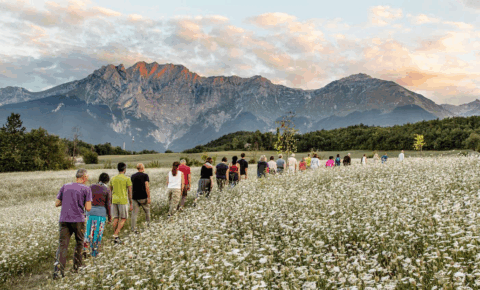
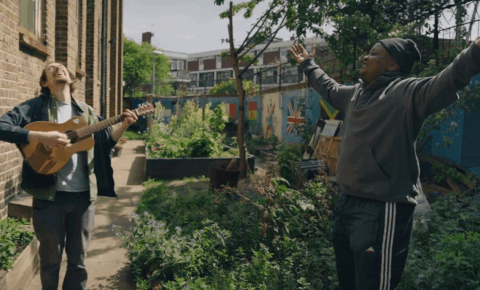
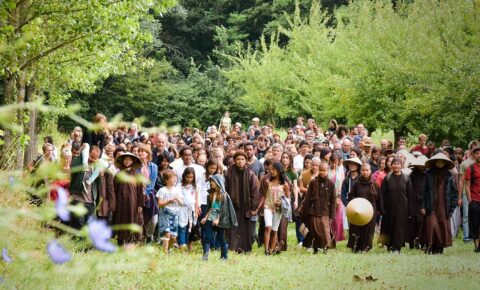
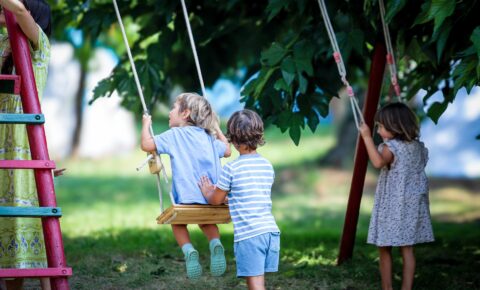
Share Your Reflections